Related Research Articles

The Local Group is the galaxy group that includes the Milky Way, where Earth is located. It has a total diameter of roughly 3 megaparsecs (10 million light-years; 9×1019 kilometres), and a total mass of the order of 2×1012 solar masses (4×1042 kg). It consists of two collections of galaxies in a "dumbbell" shape; the Milky Way and its satellites form one lobe, and the Andromeda Galaxy and its satellites constitute the other. The two collections are separated by about 800 kiloparsecs (3×106 ly; 2×1019 km) and are moving toward one another with a velocity of 123 km/s. The group itself is a part of the larger Virgo Supercluster, which may be a part of the Laniakea Supercluster. The exact number of galaxies in the Local Group is unknown as some are occluded by the Milky Way; however, at least 80 members are known, most of which are dwarf galaxies.

The Andromeda Galaxy is a barred spiral galaxy and is the nearest major galaxy to the Milky Way. It was originally named the Andromeda Nebula and is cataloged as Messier 31, M31, and NGC 224. Andromeda has a D25 isophotal diameter of about 46.56 kiloparsecs (152,000 light-years) and is approximately 765 kpc (2.5 million light-years) from Earth. The galaxy's name stems from the area of Earth's sky in which it appears, the constellation of Andromeda, which itself is named after the princess who was the wife of Perseus in Greek mythology.
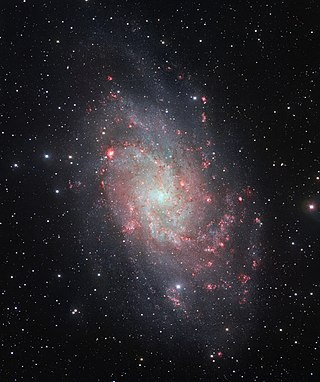
The Triangulum Galaxy is a spiral galaxy 2.73 million light-years (ly) from Earth in the constellation Triangulum. It is catalogued as Messier 33 or NGC (New General Catalogue) 598. With the D25 isophotal diameter of 18.74 kiloparsecs (61,100 light-years), the Triangulum Galaxy is the third-largest member of the Local Group of galaxies, behind the Andromeda Galaxy and the Milky Way.

The Pegasus Dwarf Spheroidal is a dwarf spheroidal galaxy about 2.7 million light-years away in the constellation Pegasus. The Pegasus Dwarf is a member of the Local Group and a satellite galaxy of the Andromeda Galaxy (M31).

NGC 891 is an edge-on unbarred spiral galaxy about 30 million light-years away in the constellation Andromeda. It was discovered by William Herschel on October 6, 1784. The galaxy is a member of the NGC 1023 group of galaxies in the Local Supercluster. It has an H II nucleus.
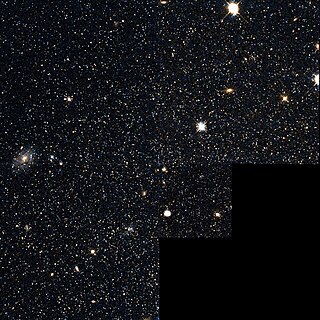
Andromeda I is a dwarf spheroidal galaxy (dSph) about 2.40 million light-years away in the constellation Andromeda. Andromeda I is part of the local group of galaxies and a satellite galaxy of the Andromeda Galaxy (M31). It is roughly 3.5 degrees south and slightly east of M31. As of 2005, it is the closest known dSph companion to M31 at an estimated projected distance of ~40 kpc or ~150,000 light-years.
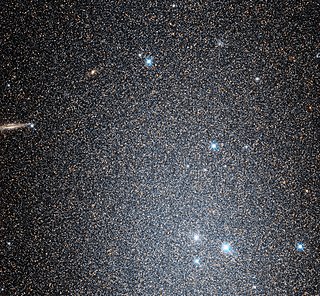
NGC 147 is a dwarf spheroidal galaxy about 2.58 Mly away in the constellation Cassiopeia. NGC 147 is a member of the Local group of galaxies and a satellite galaxy of the Andromeda Galaxy (M31). It forms a physical pair with the nearby galaxy NGC 185, another remote satellite of M31. It was discovered by John Herschel in September 1829. Visually it is both fainter and slightly larger than NGC 185. This means that NGC 147 is more difficult to see than NGC 185, which is visible in small telescopes. In the Webb Society Deep-Sky Observer's Handbook, the visual appearance of NGC 147 is described as follows:
Large, quite faint, irregularly round; it brightens in the middle to a stellar nucleus.
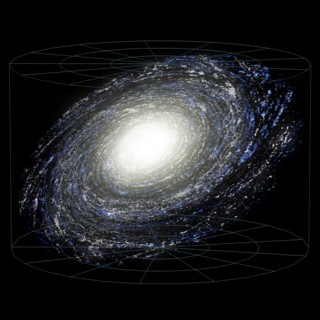
The Monoceros Ring(monoceros: Greek for 'unicorn') is a long, complex, ring of stars that wraps around the Milky Way three times. This is proposed to consist of a stellar stream torn from the Canis Major Dwarf Galaxy by tidal forces as part of the process of merging with the Milky Way over a period of billions of years, although this view has long been disputed. The ring contains 100 million solar masses and is 200,000 light years long.
The Milky Way has several smaller galaxies gravitationally bound to it, as part of the Milky Way subgroup, which is part of the local galaxy cluster, the Local Group.
Andromeda IX is a dwarf spheroidal satellite of the Andromeda Galaxy. It was discovered in 2004 by resolved stellar photometry from the Sloan Digital Sky Survey (SDSS), by Zucker et al. (2004). At the time of its discovery, it was the galaxy with the lowest known surface brightness, ΣV ≃ 26.8mags arcsec−2 and the faintest galaxy known from its intrinsic absolute brightness.

Andromeda II is a dwarf spheroidal galaxy about 2.22 Mly away in the constellation Pisces. While part of the Local Group, it is not quite clear if it is a satellite of the Andromeda Galaxy or the Triangulum Galaxy.

Andromeda IV is an isolated irregular dwarf galaxy. The moderate surface brightness, a very blue color, low current star formation rate and low metallicity are consistent with it being a small (background) dwarf irregular galaxy, perhaps similar to Local Group dwarfs such as IC 1613 and Sextans A. Arguments based on the observed radial velocity and the tentative detection of the RGB tip suggest that it lies well outside the confines of the Local Group.
Pisces II is a dwarf spheroidal galaxy situated in the Pisces constellation and discovered in 2010 in the data obtained by the Sloan Digital Sky Survey. The galaxy is located at the distance of about 180 kpc (kiloparsecs) from the Sun. It is classified as a dwarf spheroidal galaxy (dSph) meaning that it has an elongated shape with the half-light radius of about 60 pc and ratio of the axis of about 5:3.
Andromeda XXI is a moderately bright dwarf spheroidal galaxy about 859 ± 51 kiloparsecs (2.80 ± 0.17 Mly) away from the Sun in the constellation Andromeda. It is the fourth largest Local Group dwarf spheroidal galaxy. The discovery arose from the first year data of a photometric survey of the M31/M33 subgroupings of the Local Group by the Pan-Andromeda Archaeological Survey (PAndAS). This survey was conducted with the Megaprime/MegaCam wide-field camera mounted on the Canada-France-Hawaii Telescope.
Andromeda XXII is a low surface brightness dwarf spheroidal galaxy about 940–1,033 kiloparsecs away from the Sun in the constellation Pisces, of the Local Group.
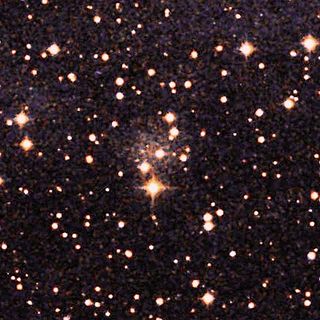
Andromeda XVIII, discovered in 2008, is a dwarf spheroidal galaxy, which is a satellite of the Andromeda Galaxy (M31). It is one of the 14 known dwarf galaxies orbiting M31. It was announced in 2010 that the orbiting galaxies lie close to a plane running through M31's center.
References
- 1 2 3 4 "Results for ANDROMEDA XIX". NASA/IPAC Extragalactic Database. Retrieved January 15, 2017.
- 1 2 3 4 Collins, Michelle L M.; Williams, Benjamin F.; Tollerud, Erik J.; Balbinot, Eduardo; Gilbert, Karoline M.; Dolphin, Andrew (2022). "A detailed star formation history for the extremely diffuse Andromeda XIX dwarf galaxy". Monthly Notices of the Royal Astronomical Society. 517 (3): 4382–4388. arXiv: 2209.12912 . Bibcode:2022MNRAS.517.4382C. doi: 10.1093/mnras/stac2794 .
- ↑ "Chart (Local Galaxies)". University of Northern Iowa. Retrieved 18 April 2012.
- 1 2 McConnachie, Alan W.; Huxor, Avon; Martin, Nicolas F.; Irwin, Mike J.; Chapman, Scott C.; Fahlman, Gregory; Ferguson, Annette M. N.; Ibata, Rodrigo A.; et al. (1 December 2008). "A Trio of New Local Group Galaxies with Extreme Properties". The Astrophysical Journal. 688 (2): 1009–1020. arXiv: 0806.3988 . Bibcode:2008ApJ...688.1009M. doi:10.1086/591313. S2CID 16950090 . Retrieved 18 April 2012.
- 1 2 3 Martin, Nicolas F.; McConnachie, Alan W.; Irwin, Mike; Widrow, Lawrence M.; Ferguson, Annette M. N.; Ibata, Rodrigo A.; Dubinski, John; Babul, Arif; et al. (1 November 2009). "PAndAS' CUBS: Discovery of Two New Dwarf Galaxies in the Surroundings of the Andromeda and Triangulum Galaxies". The Astrophysical Journal. 705 (1): 758–765. arXiv: 0909.0399 . Bibcode:2009ApJ...705..758M. doi:10.1088/0004-637X/705/1/758. S2CID 15277245 . Retrieved 18 April 2012.
